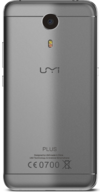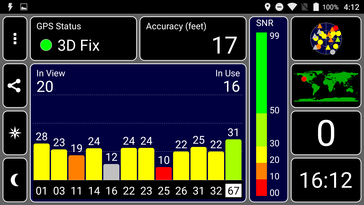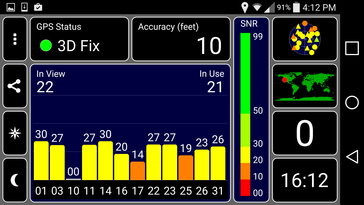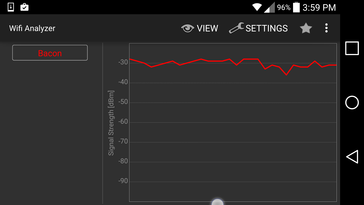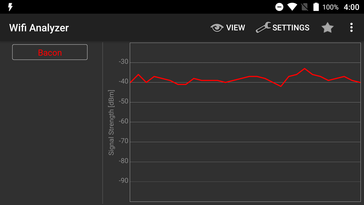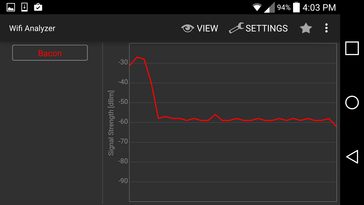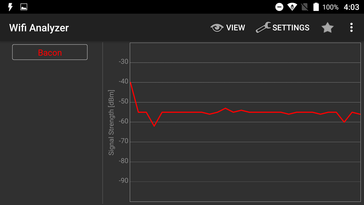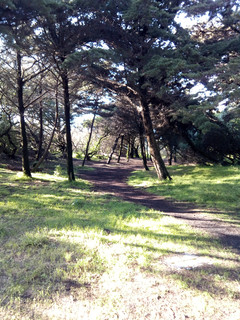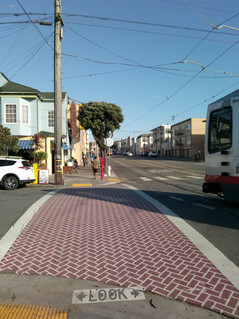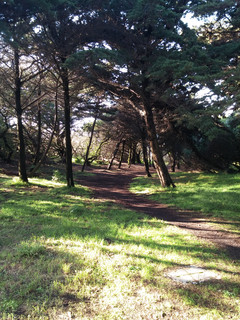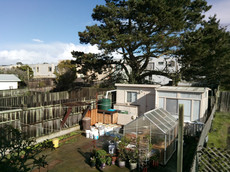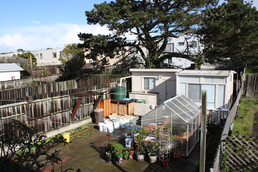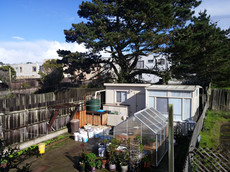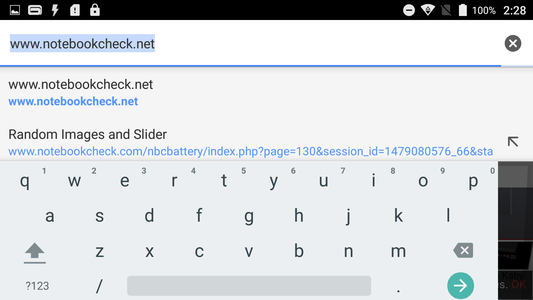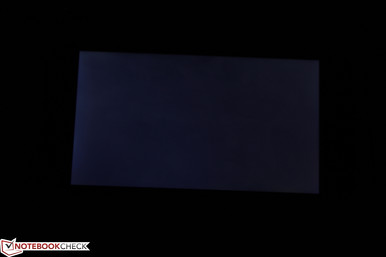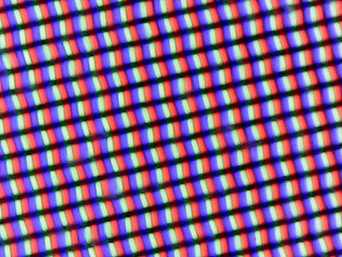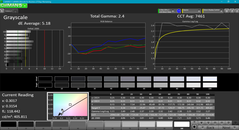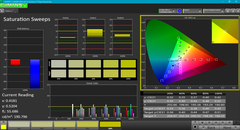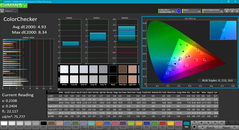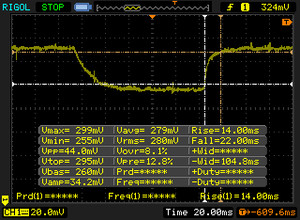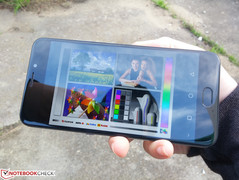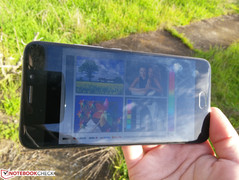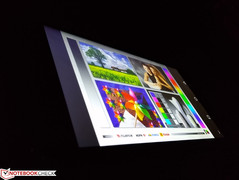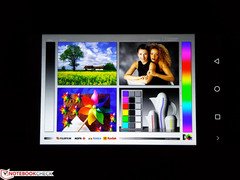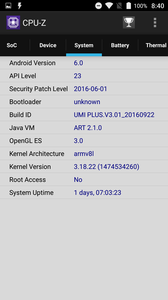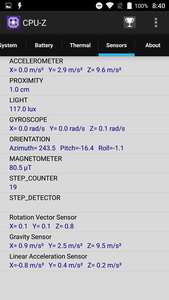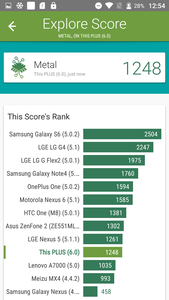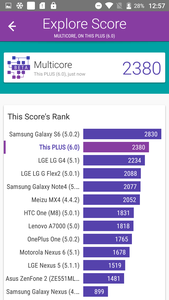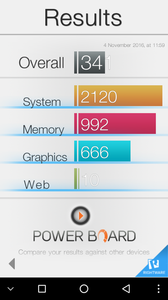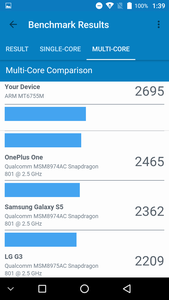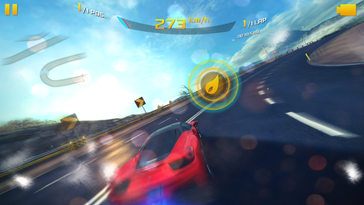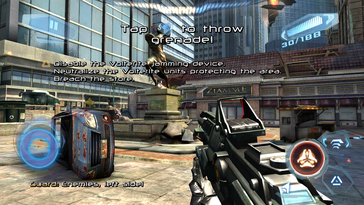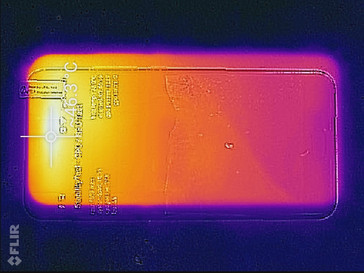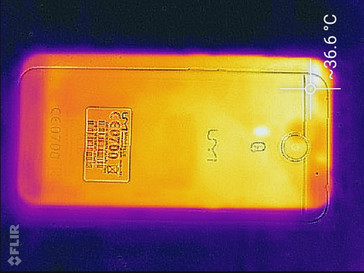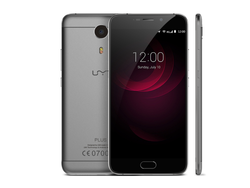UMI Plus Smartphone Review

Budget smartphones are packing more power than ever and are well on their way to being as feature-heavy as pricier mainstream alternatives. The UMI Plus is such an example and is essentially the existing UMI Max with slightly upgraded hardware and features to justify the $20 USD higher price tag. Nonetheless, the Plus sounds like a bargain at just $170 USD with its mainstream Helio P10 SoC, large 5.5-inch 1080p display, high capacity 4000 mAh non-removable battery, and roomy 4 GB of LPDDR3 RAM.
Immediate competitors include the Oukitel U7 Plus and the ZTE Blade A452, but even these 5-inch smartphones are using lower resolution 720p screens compared to the FHD UMI. It's not until the $200 to $300 USD range where smartphones begin carrying similar specifications to the UMI Plus such as the Huawei G8, Moto X Play, and Honor 5C.
We recommend checking out our existing review on the UMI Max since the Plus sports nearly all of its features and hardware.
Case
The chassis on the Plus is nearly identical to the Max except for the relocation of the rear fingerprint reader to the front Home button. The Plus is also slightly thicker (8.8 mm vs. 8.5 mm) and longer (155 mm vs. 150.8 mm) than its sibling, so they are not a perfect twin.
Quality and materials include the aluminum housing on the back and the plastic strips along the top and bottom for optimal antenna reception. Its rounded edges and corners feel strong and rigid with no unintended gaps in between. The chrome-cut finish where the metal meets the 2.5D glass on front adds another touch to the iPhone-esque design. Attempting to twist the phone results in minimal warping and no audible creaking.
Side buttons include the volume rocker, power button, and a customizable "Smart" button for instant access to the camera or a user-defined app. Like on the Max, however, these buttons are slightly on the soft side with weak feedback when pressed. The overall case still leaves a very good impression even for a sub $200 USD asking price.
As for size and weight, the UMI Plus is slightly thicker, taller, and heavier than many existing 5.5-inch smartphones. The extra mass adds a more substantial feel to the smartphone without being too heavy, so this may work to its benefit. Otherwise, most 5.5-inch alternatives are smaller with higher screen-to-body ratios.
Connectivity
Internal eMMC 5.1 memory is 32 GB to be twice that of the UMI Max, though only 25 GB is available to the end-user after factoring in the OS. MicroSD cards are supported up to 256 GB and the slot is shared with the secondary Micro-SIM card.
The USB Type-C port is limited to the USB 2.0 standard not unlike on the OnePlus 3. Thus, owners receive no benefits over the standard Micro-USB port other than the hassle-free reversible plug of USB Type-C. This unfortunately makes USB OTG more frustrating to use as you will now need USB Type-C adapters instead of Micro-USB adapters.
Wireless features from the Max return here including integrated FM radio, dual SIM functionality, Miracast, 802.11n WLAN, and Bluetooth 4.1.
Communication and GPS
According to UMI, both Micro-SIM slots support 4G LTE FDD up to 150 Mbps download (2600, 2100, 1800, 800 MHz frequencies). The two slots, however, cannot utilize 4G simultaneously as one will automatically be set to receive only. Here in the U.S., we were only able to connect to T-Mobile's 3G network with no 4G bands supported. This is unfortunately quite common on Chinese smartphones designed more for international users.
Call quality is sufficiently loud through the integrated earpiece with no significant static from both the caller and listener. In contrast, the speakerphone unfortunately sounds cheap and distorted especially on higher volume settings. Reception isn't very good either at just half bars even in a metropolitan area like the outer San Francisco.
WLAN is limited to 802.11n speeds with support for both 2.4 GHz and 5 GHz. Oddly enough, WLAN reception is weaker on the UMI compared to the LG G3 even when standing just two meters away from our EA8500 WLAN source. When moving about 15 meters away, however, reception becomes roughly the same on both smartphones.
The integrated GPS in the UMI is less accurate than on the LG G3 as shown by our GPS Test results below. We discovered similar results on the UMI Max as well, but the smartphone is nonetheless sufficient for general navigation while driving. More accurate solutions are recommended when off-road or on twisting trails.
Cameras
Camera quality from the rear Samsung 3L8 13 MP is only average. Colors have a tendency to be greener than normal, overexposed, and generally softer overall. Video recording is limited to 1080p at up to 30 FPS with unreliable auto-focusing even when panning slowly. Meanwhile, the front-facing 5 MP camera works well enough for video calls due to its low latency and automatic face detection. Performance in dim ambient lighting is also acceptable whereas most cheaper front-facing cameras are typically muddy.
Accessories and Warranty
Included extras are a needle key for inserting SIM or MicroSD cards, a European AC plug, USB Type-C charger, and a small user guide. There are no included earphones and the MicroUSB cable appears to be for charging only (no data).
Please see our Guarantees, Return Policies and Warranties FAQ for country-specific warranty information.
Input Devices
Touchscreen
The 5-point capacitive touchscreen responds quickly and reliably to scrolls and multi-touch gestures with no major latency issues. The edges and corners also respond swiftly to touch inputs without any "dead zones" or noticeable odd behavior.
The bottom Home button feels cheap to the touch. Travel is shallow and feedback is weak, so pressing down on it feels very uneven as a result. It's fortunately touch-sensitive and simply tapping on its surface will bring you back to the Home screen. The adjacent Tabs and Back touch-sensitive buttons are also present in the same positioning as a Samsung smartphone (i.e., Tabs to the left and Back to the right), but there is no backlighting for either of them.
Touch ID for fingerprint unlocking works quickly, albeit not always reliably. The sensor recognizes a finger only most of the time and we recommend saving multiple entries of the same finger to reduce the chances of errors.
Display
Subjectively, the edge-to-edge Gorilla Glass display offers a clean and crisp picture due to the dense FHD resolution. The screen itself is very close to the surface of the glass, so colors and pictures appear to "pop" to mimic the screens of costlier mainstream and flagship smartphones. Brightness levels and especially contrast levels are very high for a budget phone, although our measurements don't show the screen to be nearly as bright as on the UMI Max and it is generally still dimmer than many mainstream competitors. The maximum brightness of the center of the screen can be as high as 462 nits when automatic brightness control is active. When automatic control is deactivated, the manual brightness limit becomes slightly lower at 433 nits. The Plus is slightly brighter on the bottom half of the screen compared to the top half.
Slight backlight bleeding can be observed on the top and bottom edges of the screen when displaying all black and on maximum brightness. This is hardly noticeable during everyday use and is not significant enough to be an issue.
| |||||||||||||||||||||||||
Brightness Distribution: 86 %
Center on Battery: 432.8 cd/m²
Contrast: 1866:1 (Black: 0.232 cd/m²)
ΔE ColorChecker Calman: 4.93 | ∀{0.5-29.43 Ø4.79}
ΔE Greyscale Calman: 5.18 | ∀{0.09-98 Ø5}
Gamma: 2.4
CCT: 7461 K
| UMI Plus LTPS, 5.5", 1920x1080 | UMI Max Sharp, IPS, 5.5", 1920x1080 | Sony Xperia XZ IPS, 5.2", 1920x1080 | ZTE Axon 7 AMOLED, 5.5", 2560x1440 | Asus Zenfone 3 ZE552KL IPS, 5.5", 1920x1080 | |
|---|---|---|---|---|---|
| Response Times | -25% | -88% | 88% | -47% | |
| Response Time Grey 50% / Grey 80% * (ms) | 36 ? | 40 ? -11% | 52 ? -44% | 4.8 ? 87% | 56 ? -56% |
| Response Time Black / White * (ms) | 26 ? | 36 ? -38% | 60 ? -131% | 3.2 ? 88% | 36 ? -38% |
| PWM Frequency (Hz) | 240.4 ? | ||||
| Screen | -13% | -13% | -11% | -18% | |
| Brightness middle (cd/m²) | 432.8 | 522 21% | 544 26% | 328 -24% | 658 52% |
| Brightness (cd/m²) | 430 | 498 16% | 521 21% | 334 -22% | 633 47% |
| Brightness Distribution (%) | 86 | 86 0% | 93 8% | 88 2% | 93 8% |
| Black Level * (cd/m²) | 0.232 | 0.23 1% | 0.37 -59% | 0.66 -184% | |
| Contrast (:1) | 1866 | 2270 22% | 1470 -21% | 997 -47% | |
| Colorchecker dE 2000 * | 4.93 | 6.9 -40% | 5.8 -18% | 4.6 7% | 4.9 1% |
| Colorchecker dE 2000 max. * | 8.34 | 12.3 -47% | 9.8 -18% | 14.7 -76% | 9.1 -9% |
| Greyscale dE 2000 * | 5.18 | 9.2 -78% | 7.2 -39% | 2.8 46% | 5.8 -12% |
| Gamma | 2.4 92% | 2.38 92% | 2.18 101% | 2.29 96% | 2.26 97% |
| CCT | 7461 87% | 8687 75% | 8619 75% | 6612 98% | 7840 83% |
| Total Average (Program / Settings) | -19% /
-15% | -51% /
-28% | 39% /
14% | -33% /
-24% |
* ... smaller is better
Colors on the Plus are relatively accurate across all tested saturation levels despite having average grayscale and RGB balance. With that said, both colors are grayscale still appear to be slightly more accurate than on the UMI Max and even the Sony Xperia XZ whereas the costlier ZTE Axon 7 is far ahead.
Display Response Times
| ↔ Response Time Black to White | ||
|---|---|---|
| 26 ms ... rise ↗ and fall ↘ combined | ↗ 5.2 ms rise | |
| ↘ 20.8 ms fall | ||
| The screen shows relatively slow response rates in our tests and may be too slow for gamers. In comparison, all tested devices range from 0.1 (minimum) to 240 (maximum) ms. » 61 % of all devices are better. This means that the measured response time is worse than the average of all tested devices (20.3 ms). | ||
| ↔ Response Time 50% Grey to 80% Grey | ||
| 36 ms ... rise ↗ and fall ↘ combined | ↗ 14 ms rise | |
| ↘ 22 ms fall | ||
| The screen shows slow response rates in our tests and will be unsatisfactory for gamers. In comparison, all tested devices range from 0.165 (minimum) to 636 (maximum) ms. » 49 % of all devices are better. This means that the measured response time is worse than the average of all tested devices (31.7 ms). | ||
Screen Flickering / PWM (Pulse-Width Modulation)
| Screen flickering / PWM not detected | |||
In comparison: 53 % of all tested devices do not use PWM to dim the display. If PWM was detected, an average of 8152 (minimum: 5 - maximum: 343500) Hz was measured. | |||
Performance
The UMI Plus uses the same Helio P10 MT6755 SoC as many other mainstream smartphones including the HTC Desire 10 Pro, Blackview R7, and the Sony Xperia XA. It also carries more RAM than the immediate competition at 4 GB compared to 2 to 3 GB on the Honor 5C and even the similar UMI Max. Raw processor performance according to 3DMark Ice Storm Physics is about 30 to 40 percent slower than the flagship Snapdragon 820 found on many flagship smartphones.
Transfer rates are slow from the integrated MicroSD reader. Sequential read and write speeds with our Toshiba Exceria Pro M401 MicroSD test card average about 36 MB/s and 22 MB/s, respectively, while the MicroSD card itself is rated for maximum read and write rates of 90 MB/s and 80 MB/s, respectively.
Subjectively, system performance is very fast with only minor latency and hiccups when multi-tasking between heavy applications like games. The Android Marshmallow experience feels pure even though the smartphone uses an UMI-specific UI since the overlay stays close to the vanilla Android visual style.
| AnTuTu v6 - Total Score | |
| Google Pixel XL 2016 | |
| Sony Xperia XZ | |
| ZTE Axon 7 | |
| Asus Zenfone 3 ZE552KL | |
| Honor 5C | |
| UMI Super Euro Edition | |
| UMI Max | |
| UMI Plus | |
| Acer Liquid Z630S | |
| Leagoo Shark 1 | |
| Coolpad Modena 2 | |
| Geekbench 4.0 | |
| Compute RenderScript Score | |
| Google Pixel XL 2016 | |
| Sony Xperia XZ | |
| Asus Zenfone 3 ZE552KL | |
| UMI Super Euro Edition | |
| UMI Plus | |
| 64 Bit Multi-Core Score | |
| Google Pixel XL 2016 | |
| Asus Zenfone 3 ZE552KL | |
| ZTE Axon 7 | |
| Sony Xperia XZ | |
| UMI Super Euro Edition | |
| UMI Max | |
| UMI Plus | |
| Coolpad Modena 2 | |
| 64 Bit Single-Core Score | |
| Sony Xperia XZ | |
| Google Pixel XL 2016 | |
| ZTE Axon 7 | |
| Asus Zenfone 3 ZE552KL | |
| UMI Max | |
| UMI Super Euro Edition | |
| UMI Plus | |
| Coolpad Modena 2 | |
| PCMark for Android | |
| Work 2.0 battery life | |
| Sony Xperia XZ | |
| Work 2.0 performance score | |
| Sony Xperia XZ | |
| Work performance score | |
| Asus Zenfone 3 ZE552KL | |
| Honor 5C | |
| Sony Xperia XZ | |
| ZTE Axon 7 | |
| Google Pixel XL 2016 | |
| UMI Super Euro Edition | |
| UMI Max | |
| Acer Liquid Z630S | |
| Leagoo Shark 1 | |
| Coolpad Modena 2 | |
| UMI Plus | |
| JetStream 1.1 - Total Score | |
| Google Pixel XL 2016 | |
| Sony Xperia XZ | |
| ZTE Axon 7 | |
| Asus Zenfone 3 ZE552KL | |
| Honor 5C | |
| UMI Super Euro Edition | |
| UMI Plus | |
| UMI Max | |
| Acer Liquid Z630S | |
| Leagoo Shark 1 | |
| Coolpad Modena 2 | |
| Mozilla Kraken 1.1 - Total | |
| Coolpad Modena 2 | |
| Leagoo Shark 1 | |
| Acer Liquid Z630S | |
| UMI Plus | |
| UMI Max | |
| UMI Super Euro Edition | |
| Honor 5C | |
| Asus Zenfone 3 ZE552KL | |
| ZTE Axon 7 | |
| Sony Xperia XZ | |
| Google Pixel XL 2016 | |
| Octane V2 - Total Score | |
| Sony Xperia XZ | |
| Google Pixel XL 2016 | |
| ZTE Axon 7 | |
| Asus Zenfone 3 ZE552KL | |
| UMI Max | |
| Honor 5C | |
| UMI Super Euro Edition | |
| UMI Plus | |
| Leagoo Shark 1 | |
| Acer Liquid Z630S | |
| Coolpad Modena 2 | |
* ... smaller is better
Games
3D titles including Asphalt 8 and N.O.V.A. 3 play without any major issues on the UMI Plus. Raw graphics performance from the integrated Mali-T860 MP2 is about 6x to 7x slower than the new Qualcomm Adreno 530 as found on the Google Pixel XL and the ZTE Axon 7 according to 3DMark Sling Shot. This puts the UMI Plus in the same ballpark as the mainstream Adreno 506 as found on the ZenFone 3 ZE552KL and ZTE Axon 7 Max.
Emissions
Temperature
Surface temperatures are warmer on the top half compared to the bottom as is common on many smartphones due to the positioning of the internal battery. As a result, the phone will feel very warm when held up to the ear after a gaming or browsing session. We were able to record a surface temperature of over 46 C at its worst when under extreme loads with the front of the device being noticeably warmer than the back. Our UMI Plus also runs warmer than our UMI Max, which correlates to our higher power demands of the Plus as shown in our Power Consumption section below.
(-) The maximum temperature on the upper side is 46.4 °C / 116 F, compared to the average of 35.2 °C / 95 F, ranging from 21.9 to 247 °C for the class Smartphone.
(+) The bottom heats up to a maximum of 36.8 °C / 98 F, compared to the average of 34 °C / 93 F
(+) In idle usage, the average temperature for the upper side is 27.1 °C / 81 F, compared to the device average of 32.9 °C / 91 F.
Speakers
UMI advertises "clean and powerful" Hi-Fi audio from the integrated speakerphone. In reality, however, sound quality is poor and extremely narrow in range as shown by our microphone measurements below. Music playback is very high-pitched and unnatural since bass frequencies are poorly reproduced and is almost non-existent. The pricier Phab 2 Pro, for example, outputs a wider frequency range down to the 250 Hz range in a direct comparison.
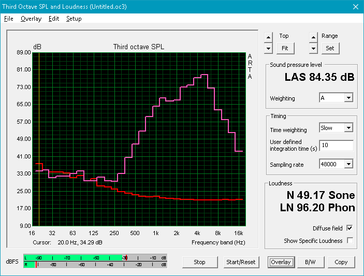
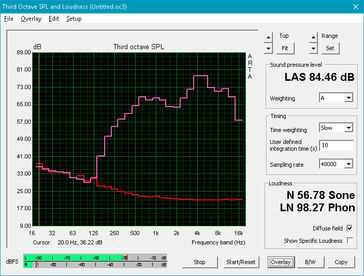
UMI Plus audio analysis
(+) | speakers can play relatively loud (84.3 dB)
Bass 100 - 315 Hz
(-) | nearly no bass - on average 27.4% lower than median
(+) | bass is linear (5.5% delta to prev. frequency)
Mids 400 - 2000 Hz
(±) | higher mids - on average 8.6% higher than median
(±) | linearity of mids is average (12.7% delta to prev. frequency)
Highs 2 - 16 kHz
(±) | higher highs - on average 12.9% higher than median
(±) | linearity of highs is average (12.9% delta to prev. frequency)
Overall 100 - 16.000 Hz
(-) | overall sound is not linear (42.2% difference to median)
Compared to same class
» 86% of all tested devices in this class were better, 0% similar, 13% worse
» The best had a delta of 11%, average was 35%, worst was 134%
Compared to all devices tested
» 95% of all tested devices were better, 0% similar, 5% worse
» The best had a delta of 4%, average was 24%, worst was 134%
Apple MacBook 12 (Early 2016) 1.1 GHz audio analysis
(+) | speakers can play relatively loud (83.6 dB)
Bass 100 - 315 Hz
(±) | reduced bass - on average 11.3% lower than median
(±) | linearity of bass is average (14.2% delta to prev. frequency)
Mids 400 - 2000 Hz
(+) | balanced mids - only 2.4% away from median
(+) | mids are linear (5.5% delta to prev. frequency)
Highs 2 - 16 kHz
(+) | balanced highs - only 2% away from median
(+) | highs are linear (4.5% delta to prev. frequency)
Overall 100 - 16.000 Hz
(+) | overall sound is linear (10.2% difference to median)
Compared to same class
» 7% of all tested devices in this class were better, 2% similar, 91% worse
» The best had a delta of 5%, average was 18%, worst was 53%
Compared to all devices tested
» 4% of all tested devices were better, 1% similar, 94% worse
» The best had a delta of 4%, average was 24%, worst was 134%
Frequency Comparison (Checkbox selectable!)
Graph 1: Pink Noise 100% Vol.; Graph 2: Audio off
Energy Management
Power Consumption
The UMI Plus appears to be more demanding than the UMI Max even after double-checking our measurements. Idling on the Home screen will draw about 2 to 3 Watts while running StabilityTest Classic will demand almost 8 Watts. Running the more demanding StabilityTest CPU+GPU benchmark will throttle the performance of the Plus down to almost 5 Watts.
| Off / Standby | |
| Idle | |
| Load |
|
Key:
min: | |
| UMI Plus Helio P10 MT6755, Mali-T860 MP2, , LTPS, 1920x1080, 5.5" | UMI Max Helio P10 MT6755, Mali-T860 MP2, 16 GB eMMC Flash, IPS, 1920x1080, 5.5" | Sony Xperia XZ 820 MSM8996, Adreno 530, 32 GB eMMC Flash, IPS, 1920x1080, 5.2" | ZTE Axon 7 820 MSM8996, Adreno 530, 64 GB eMMC Flash, AMOLED, 2560x1440, 5.5" | Asus Zenfone 3 ZE552KL 625, Adreno 506, 64 GB eMMC Flash, IPS, 1920x1080, 5.5" | |
|---|---|---|---|---|---|
| Power Consumption | 53% | -19% | 25% | 36% | |
| Idle Minimum * (Watt) | 2.6 | 1.02 61% | 1.76 32% | 0.64 75% | 0.83 68% |
| Idle Average * (Watt) | 3.2 | 1.53 52% | 3.6 -13% | 0.84 74% | 2.11 34% |
| Idle Maximum * (Watt) | 3.3 | 1.62 51% | 4.06 -23% | 0.87 74% | 2.12 36% |
| Load Average * (Watt) | 7.7 | 2.91 62% | 7 9% | 6.02 22% | 3.41 56% |
| Load Maximum * (Watt) | 4.8 | 2.93 39% | 9.52 -98% | 10.45 -118% | 5.46 -14% |
* ... smaller is better
Battery Life
Like on the UMI Max, users can expect over 9 hours of constant WLAN use on a brightness level setting of about 40 percent (150 nits). High loads on maximum display brightness will last for just under 5 hours.
The supplied wall charger outputs at up to 1.67 A whereas off-the-shelf fast-charging chargers can output higher at 2 A or 3 A.
| UMI Plus Helio P10 MT6755, Mali-T860 MP2, Wh | UMI Max Helio P10 MT6755, Mali-T860 MP2, Wh | Sony Xperia XZ 820 MSM8996, Adreno 530, 11 Wh | ZTE Axon 7 820 MSM8996, Adreno 530, Wh | Asus Zenfone 3 ZE552KL 625, Adreno 506, Wh | |
|---|---|---|---|---|---|
| Battery runtime | 4% | -25% | -4% | 25% | |
| Reader / Idle (h) | 22 | 18.8 -15% | 28.9 31% | 25 14% | |
| WiFi v1.3 (h) | 9.4 | 9.8 4% | 7.3 -22% | 6.9 -27% | 13.3 41% |
| Load (h) | 4.9 | 3.1 -37% | 4.1 -16% | 5.9 20% |
Pros
Cons
Verdict
UMI has created a solid smartphone with impressive specifications for under $200 USD. It performs as smoothly as one would expect from a costlier mainstream smartphone without cutting popular features like the fingerprint reader, MicroSD card, or even the USB Type-C port. Wrap everything into a relatively sturdy design and you have a smartphone that's hard to beat for the price.
Like most budget devices, however, the devil is in the details. Its dimensions are large even for a 5.5-inch smartphone and its rear camera quality is more representative of the budget category. Speakerphone quality is poor and all of its buttons could have benefited from stronger feedback when pressed. Call reception is also a mixed bag in our particular test area and 4G may not be available for North American users. The vibrate setting is weak and its GPS is only average in terms of accuracy.
If the list of drawbacks aren't a concern for day-to-day use, then owners should be satisfied with the core hardware performance and general quality of the UMI Plus.
UMI Plus
- 11/27/2016 v5.1 (old)
Allen Ngo






